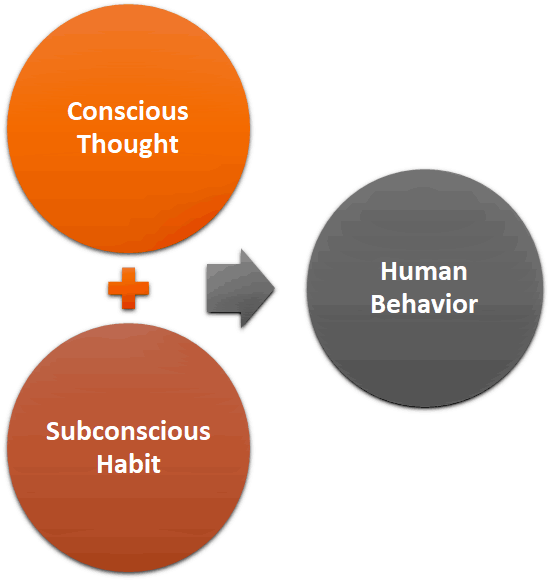Dr. Wendy Wood opens her book Good Habits, Bad Habits with a familiar story. A woman wanted very much to lose weight. To bolster her efforts, she set a firm intention, made a public declaration of her goal, and secured support from her peers. Unfortunately, this seemingly well-conceived plan did not produce the desired result. The excess body weight remained along with the added burden of defeat.
I’ve lived through that disheartening cycle many times. I’ve set out to lose weight and/or exercise regularly under the assumption that the right combination of motivation, willpower, and social supports would get it done. I’d tell myself: How hard can it be to push yourself away from the table or find 30 minutes a day to work out? As it turns out, harder than I thought…
 Our minds are composed of two separate but interconnected mechanisms that guide behavior. Our executive control function provides the resources most of us leverage in pursuit of goals – e.g., planning, working memory, attention control, problem solving, progress monitoring, and willpower. These energy-intensive faculties are well-suited to tasks that require substantive mental lifting – e.g., learning new skills, navigating unfamiliar circumstances, sifting through complex problems, setting goals and crafting action plans to meet them. We don’t need them for the myriad of routine tasks that fill our waking hours: brushing teeth, getting dressed, walking, even (by and large) driving a car. For life’s mundane activities, we rely upon subconscious habits that receive signals and cues from the conscious mind and then go to work on their own.
Our minds are composed of two separate but interconnected mechanisms that guide behavior. Our executive control function provides the resources most of us leverage in pursuit of goals – e.g., planning, working memory, attention control, problem solving, progress monitoring, and willpower. These energy-intensive faculties are well-suited to tasks that require substantive mental lifting – e.g., learning new skills, navigating unfamiliar circumstances, sifting through complex problems, setting goals and crafting action plans to meet them. We don’t need them for the myriad of routine tasks that fill our waking hours: brushing teeth, getting dressed, walking, even (by and large) driving a car. For life’s mundane activities, we rely upon subconscious habits that receive signals and cues from the conscious mind and then go to work on their own.
Dr. Wood studied college students to measure the amount of time they were engaged in activities without thinking about them. Overall, they spent 43% of their time on auto-pilot. Some activities proved more mindless than others: taking care of hygiene (88%), completing tasks at work (55%), watching TV (48%), exercising (44%). A subsequent multigenerational study (ages 17-79) revealed the same 43% of habit-driven activities with no material difference among age groups or personality profiles. However, longer work days and higher stress environments heightened use of mindless habits.
This bifurcation makes evolutionary sense. There are limits to our executive capacity. We get tired. Our attention wanders, and motivation wanes. To conserve our thinking power for the truly consequential, we use shortcuts to trigger behaviors without going through the effort of thinking about them intensely. In fact, we can pretty much make any behavior habitual so long as we do it the same way repeatedly in response to a cue. But here’s the rub: The same mechanism that inculcates healthy behaviors also codifies undesirable ones. And once habits have been formed and seated into the deep recesses of our minds, they have real staying power.
Because habits work outside our conscious awareness, we fail to recognize the power they wield. Our overconfidence in our ability to act on thoughts, feelings, and intentions renders us blind to unconscious influences. For example:
- We tend to eat most or all of what’s on our plates; bigger plates encourage more caloric intake than smaller ones. The same holds true for bags (or buckets) of popcorn at the movie theater.
- If unhealthy snacks stare us in the face every time we open the pantry, we’ll be primed to think about them and face an overwhelming desire to partake.
- When engaged in social activities, we tend to eat the snacks that are closest to us. (Word to the wise: Find a seat by the crudités!)
- If we follow the same patterned response after work – drop the keys, grab a cold drink, plop on the sofa, check the iPhone – we probably won’t throw on our running shoes and go for a jog. It’s taxing to ask our tired minds to exercise decision-making and willpower.
A fascinating study revealed that persons who scored the highest in self-control seldom reported having to resist temptation. They forged habits in which beneficial actions became their default choices. Their environments and life patterns supported their high level goals without creating a sense of deprivation. By contrast, folks who scored low in self-control constantly battled desires that conflicted with their goals. Their habits did not work in their favor. They had to work hard to keep their impulses under control.
Recognizing the efficiency with which the unconscious mind works, Dr. Wood advocates forging habits that align with our goals. This strategy preempts the battle between conscious decision making and habitual, automatic responses. But we need to understand how habits work if we want to harness their power… a topic I look forward to covering in next week’s post.